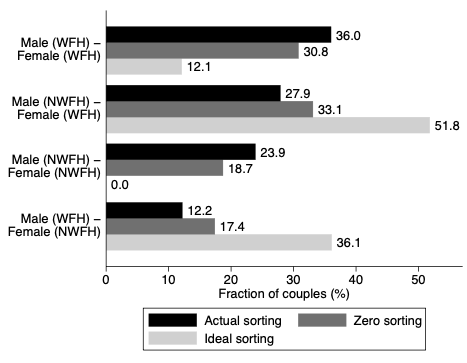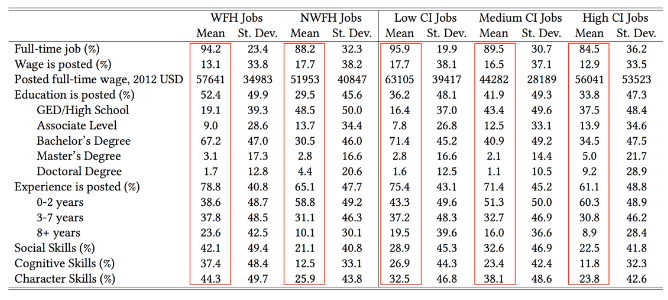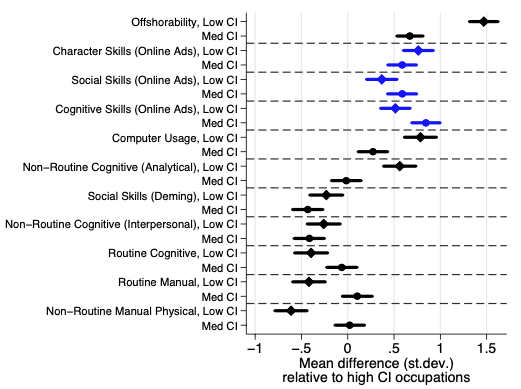To reduce the spread of COVID-19, many countries imposed mitigation measures such as lockdowns and stay-at-home orders, forcing many workers to work from home. However, a sizeable fraction of jobs cannot be performed remotely. For example, in the US, 63% of jobs cannot be done remotely (Dingel and Neiman 2020). In addition to this, several studies show that the less developed a country is, the lower the ability for citizens to work from home (Berg et al. 2020, Gottlieb et al. 2020, Hatayama et al. 2020). It comes as no surprise that the feasibility of remote work and contact intensity of occupations matter for the wellbeing of workers (Goldberg 2020). Mongey et al. (2020) show that US workers in non-teleworkable occupations are less educated, have lower income, and have experienced greater declines in employment following the COVID-19 outbreak. Bick et al. (2020) estimate that more than 70% of the US workers that could work from home did so in May 2020. Alon et al. (2020) discuss the implications of the current economic downturn for gender inequality. Further, Almagro and Orane-Hutchinson (2020) show the importance of contact intensity across occupations in explaining the disparities in COVID-19 incidence across neighbourhoods in New York City. Overall, the nature of work significantly affects the health and economic outcomes for workers.
In a recent study (Malkov 2020) I investigate how ‘teleworkability’ and contact intensity of occupations shape the distribution of health, labour income, and unemployment risks. The extent of exposure to these risks greatly depends on the occupation type. Workers who have teleworkable (work-from-home/WFH) jobs face a lower unemployment risk than those who have non-teleworkable (not-work-from-home, NWFH) jobs. Workers whose occupations require low contact intensity (low CI) at the workplace face lower risk of being infected than those with high contact intensity (high CI). I consider two contexts. First, I show that the existing spousal occupational sorting in the US matters for the distribution of the aforementioned risks. Second, I document sizeable differences in the skill requirements and task content across the occupation types. These differences matter for labour income and unemployment risks.
Occupational sorting in couples
Married couples constitute about 48% of all the US households (US Census Bureau 2019). The sign and extent of occupational sorting in couples plays an important role during the COVID-19 pandemic because it can either exacerbate or mitigate health and labour income risks.
First, the presence of the other family members creates the risk of intra-household contagion. Under positive sorting (i.e. when it is more likely that both spouses have either high-contact-intensity or low-contact-intensity jobs), this risk is heavily concentrated in high-contact-intensity couples. Under negative sorting, the risk of intra-household contagion is more evenly distributed across the couples. In general, more negative occupational sorting, based on contact intensity, is associated with greater fraction of individuals who are exposed to COVID-19 health risk. Second, the presence of an employed spouse serves as insurance against labour income shocks. Under positive sorting (i.e. when it is more likely that both spouses have either teleworkable or non-teleworkable jobs), labour income risk is heavily concentrated in non-teleworkable couples. Under negative sorting, this risk is distributed across the couples more evenly (and is easier to insure). In general, more positive occupational sorting (based on teleworkability) is associated with greater fraction of individuals who are heavily exposed to labour income risk. Overall, the patterns of occupational sorting in couples have crucial importance for the distribution of risks and, as a consequence, may have different policy implications.
Figure 1 compares the actual distribution of spouses in ‘dual-earner’ couples in the US against two counterfactual distributions: zero sorting and ‘ideal’ sorting. For teleworkability-based distribution, I define ideal sorting to be the distribution where the fraction of couples with both spouses in non-teleworkable jobs is minimised. The actual sorting creates 23.9% of couples where both spouses have non-teleworkable occupations and are hence exposed to greater labour income risk. Under zero sorting, this fraction goes down to 18.7 %. Under ideal sorting, it further reduces to zero. For contact-intensity-based distribution, I define ideal sorting to be the distribution where the fraction of ‘mixed’ couples is minimised (i.e. the risk of intra-household contagion is minimised). The actual sorting creates 67.3% of couples with at least one spouse whose job requires a high contact intensity at the workplace. These couples are exposed to greater intra-household contagion risk. Under zero sorting, this fraction goes up to 69.6%. Under ideal sorting, it falls down to 52.1%.
Figure 1 Distribution of spouses by occupations: Actual, zero, and ideal sorting
a) Teleworkability-based classification
b) Contact-intensity-based classification
Notes: I use 2018 American Community Survey data to construct this figure. The classification of occupations in terms of teleworkability (WFH/NWFH) and contact intensity (low CI/high CI) is from Mongey et al. (2020).
Differences in skill requirements and task content
Those individuals who lose their jobs during the current economic downturn will probably want to find a job that can be performed at home. Skill mismatch constitutes one of the factors that affect the likelihood of finding a new job (Guvenen et al. 2020). The greater the differences in skill requirements between teleworkable and non-teleworkable (or high- and low-contact-intensity occupations), the less likely a displaced worker can switch an occupation.
To address this question, I use Gartner Talent Neuron data on online vacancy ads.1 Table 1 shows the descriptive statistics. First, comparing teleworkable and non-teleworkable occupations, it is evident that vacancies posted regarding teleworkable occupations are more likely to be full-time jobs, are more likely to request education and experience requirements, but are less likely post a wage. Conditional on posting an education requirement, they more likely require a college degree. Conditional on posting an experience requirement, they more likely require longer prior experience. Finally, teleworkable jobs more likely require social, cognitive, and character skills. Despite the fact that the work can be performed remotely, workers still need to demonstrate the ability to communicate, cooperate, and negotiate (Baldwin 2020).
Second, I compare the occupations of different contact intensity. Vacancy postings in low-contact-intensity occupations more likely advertise full-time jobs, post a wage, and state an experience requirement. Conditional on posting an experience requirement, they more likely require longer prior experience. Conditional on posting an education requirement, these occupations are more likely to require a college degree. Finally, comparing low- and high-contact-intensity occupations, we see that the former group are more likely require social, cognitive, and character skills.
Table 1 Descriptive statistics of online job ads data
Notes: I use Gartner TalentNeuron data on online vacancy ads in Iowa, Minnesota, North Dakota, South Dakota, and Wisconsin for September 2014-September 2018 to produce this table. The classification of occupations in terms of teleworkability (WFH/NWFH) is from Dingel and Neiman (2020). The classification of occupations in terms of contact intensity (low CI/medium CI/high CI) is from Leibovici et al. (2020). Posted full-time wages are adjusted for inflation to 2012 dollars using the personal consumption expenditures (PCE) price index.
Next, I use O*NET data to construct the measures of non-routine cognitive (analytical and interpersonal), routine cognitive, routine manual, and non-routine manual physical tasks (Acemoglu and Autor 2011). The differences in the task content of jobs (considered through the lens of routine and non-routine occupations) matter for the discussion about the US labour market polarisation. Further, I also construct the measures of ‘offshorability’, computer usage, and social skills (Deming 2017). Figure 2 shows the mean differences in characteristics between teleworkable and non-teleworkable (left panel), and low- and medium- against high-contact-intensity occupations (right panel). Teleworkable occupations, on average, have a higher score of non-routine cognitive tasks, both analytical (+0.88 standard deviation) and interpersonal (+0.41 standard deviation), but lower scores along non-routine manual physical (-1.33 standard deviation) and routine manual (-1.16 standard deviation) dimensions. Low-contact-intensity occupations, on average, have a lower score of non-routine cognitive (interpersonal), routine cognitive, routine manual, and non-routine manual physical tasks, compared to high-contact-intensity occupations. Furthermore, teleworkable occupations and occupations of lower contact intensity are more likely to be offshorable and require greater use of the computer. Compared to the results of Foote and Ryan (2015)–who document that job losses during the Great Recession were concentrated among workers in routine cognitive occupations–job losses during the COVID-19 economic downturn are more widespread. Both non-teleworkable and high-contact-intensity occupations (that suffer the most) are also heavily represented in non-routine manual occupations.
Figure 2a Mean difference between characteristics of teleworkable and non-teleworkable occupations
Figure 2b Mean difference between characteristics of low-contact-intensity/medium-contact-intensity occupations and high-contact-intensity occupations
Notes: The classification of occupations in terms of teleworkability (WFH/NWFH) is from Dingel and Neiman (2020). The classification of occupations in terms of contact intensity (low CI/medium CI/high CI) is from Leibovici et al. (2020). Each characteristic on y-axis is standardized to have mean zero and standard deviation one. Point estimates for difference in means are given by the markers, and 95 percent confidence intervals are given by the lines through each marker. The occupations are defined at the O*NET SOC level.
Policy implications
My results suggest several policy implications and highlight the importance of targeted policies (Furman 2020, Gopinath 2020). First, about 67% of the US dual-earner couples are exposed to excessive health risk through intra-household contagion. Targeting individuals who work in occupations that require high-contact-intensity with testing and vaccination, and providing them with protective equipment, would allow for the mitigation of this transmission channel. Second, a significant fraction of couples where both spouses have non-teleworkable jobs (and are hence exposed to greater unemployment risk) suggests that occupation-specific transfers, or transfers based on joint spousal earnings, could potentially be desirable. Third, significant differences in skill requirements imply that workers in non-teleworkable and high-contact-intensity occupations (who bear higher risk of losing a job during the COVID-19 recession) may incur not only short-run losses, but also long-run losses (Portes 2020) originated from skill mismatch. While the unemployment benefits or stimulus payments for COVID-19 relief can insure these workers against short-run losses, they fall short of insuring long-run losses. I also emphasize that existing differences in skill requirements may create constraints on policies that propose training programmes for the unemployed. While some hard skills (e.g. basic computer skills) can be acquired through training, social and character skills are much harder to adjust (Lise and Postel-Vinay 2020). The skill requirements may respond to the crisis as well. For example, Hershbein and Kahn (2018) show that routine cognitive occupations demonstrated increase in skill requirements during the Great Recession. How the firms will respond this time around is still an open question.
Author’s note: The views expressed herein are those of the author and not necessarily those of the Federal Reserve Bank of Minneapolis or the Federal Reserve System.
References
Acemoglu, D and D Autor (2011), “Skills, Tasks and Technologies: Implications for Employment and Earnings”, Handbook of Labor Economics 4(B): 1043-1171.
Alon, T, M Doepke, J Olmstead-Rumsey and M Tertilt (2020), “The Impact of COVID-19 on Gender Equality”, VoxEU.org, 19 April.
Almagro, M and A Orane-Hutchinson (2020), “The Determinants of the Differential Exposure to COVID-19 in New York City and Their Evolution over Time”, Covid Economics: Vetted and Real-Time Papers 13: 31-50.
Baldwin, R (2020), “Covid, Hysteresis, and the Future of Work”, VoxEU.org, 29 May.
Berg, J, F Bonnet and S Soares (2020), “Working from Home: Estimating the Worldwide Potential”, VoxEU.org, 11 May.
Bick, A, A Blandin and K Mertens (2020), “Work from Home After the COVID-19 Outbreak”, working paper.
Deming, D J (2017), “The Growing Importance of Social Skills in the Labor Market”, Quarterly Journal of Economics 132: 1593-1640.
Dingel, J and B Neiman (2020), “How Many Jobs Can be Done at Home?”, VoxEU.org, 07 April.
Foote, C L and R W Ryan (2015), “Labor-Market Polarization over the Business Cycle,” NBER Macroeconomics Annual 29: 371-413.
Furman, J (2020), “Protecting People Now, Helping the Economy Rebound Later”, in Baldwin, R and B Weder di Mauro (eds) Mitigating the COVID Economic Crisis: Act Fast and Do Whatever It Takes, VoxEU.org eBook, CEPR.
Goldberg, P (2020), “Policy in the Time of Coronavirus”, in Baldwin, R and B Weder di Mauro (eds) Mitigating the COVID Economic Crisis: Act Fast and Do Whatever It Takes, VoxEU.org eBook, CEPR.
Gopinath, G (2020), “Limiting the Economic Fallout of the Coronavirus with Large Targeted Policies”, in Baldwin, R and B Weder di Mauro (eds) Mitigating the COVID Economic Crisis: Act Fast and Do Whatever It Takes, VoxEU.org eBook, CEPR.
Gottlieb, C, J Grobovsek and M Poschke (2020), “Working from Home across Countries”, Covid Economics: Vetted and Real-Time Papers 8: 71-91.
Guvenen, F, B Kuruscu, S Tanaka and D Wiczer (2020), “Multidimensional Skill Mismatch”, American Economic Journal: Macroeconomics 12: 210-244.
Hatayama, M, M Viollaz and H Winkler (2020), “Jobs’ Amenability to Working from Home: Evidence from Skills Surveys for 53 Countries”, Covid Economics: Vetted and Real-Time Papers 19: 211-240.
Hershbein, B and L B Kahn (2018), “Do Recessions Accelerate Routine-Biased Technological Change? Evidence from Vacancy Postings”, American Economic Review 108: 1737-1772.
Leibovici, F, A M Santacreu and M Famiglietti (2020), “Social Distancing and Contact- Intensive Occupations”, FRB St. Louis Technical Report.
Lise, J and F Postel-Vinay (2020), “Multidimensional Skills, Sorting, and Human Capital Accumulation”, American Economic Review (forthcoming).
Malkov, E (2020), “Nature of Work and Distribution of Risk: Evidence from Occupational Sorting, Skills, and Tasks”, Covid Economics: Vetted and Real-Time Papers 34: 15-49.
Mongey, S, L Pilossoph and A Weinberg (2020), “Which Workers Bear the Burden of Social Distancing Policies?”, Covid Economics: Vetted and Real-Time Papers 12: 69-86.
Portes, J (2020), “The Lasting Scars of the Covid-19 Crisis: Channels and Impacts”, VoxEU.org, 01 June.
Endnotes
1 The access to the data is provided by RealTime Talent.








